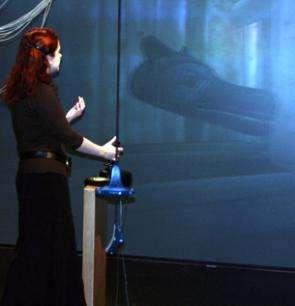A little virtual something for under the tree

Don't despair if your kids are clamouring for the Nintendo Wii or the Playstation 3 this Christmas - at least those are more affordable than the $1.5-million virtual reality lab in the University of Alberta's Computer Science building.
While the games might have some spectacular graphics, the potential for discovery in the U of A Advanced Man-Machine Interface laboratory is unlimited.
"You come here and you look at what this is being used for, and your imagination just kind of takes off," said PhD candidate Robyn Taylor.
Standing in the middle of 'the cave' - three walls that project 3-D images generated on a nearby computer - Taylor watched the spiralling arcs of a computer-generated magnetosphere whirl by.
"This is a more representational type of visualization. It's taking a large data set, the Earth's magnetic field, and mapping it to this sort of representation," she said, as the lines that encircle our planet swooped over her head. "Obviously, it doesn't look like this in real life, but those are glyphs - shapes that have properties that we try to map to different data properties. So, if we know something about the different strengths of these magnetic currents, we can map that to the size of the cones you're seeing here."
Other images that took shape between the three walls included a map of Edmonton, complete with road signs, a museum filled with Haida artefacts and a 3-D image of a molecule.
"This allows you to take artefacts that you might not necessarily want to take out of their environment, digitally scan them and then you can get a realistic perception of what they look like," said Taylor, using a joystick to bring her closer to the image of a large wooden mask. "So, the data here is as accurate as it's going to be, in terms of actual size, actual details and actual geometry. Depending on the resolution of the laser scanner, you can get extremely accurate representation."
The huge molecule image can help scientists discover and explain how elements react to one another, said Jeff Ryan, a research assistant in the lab. "For instance, if you're running a model to see how other molecules, or other atoms, in this case, will interact with it, having a 3-D perspective just gives you a better idea of how things would work in the real world."
The visualization can help teach the fundamentals of science, added Taylor.
"You don't have to imagine, you don't have to project in your head, how it would fit," she said. "Especially for teaching, a student might not have a real good grasp of how the interaction would work, and having a real, literal interpretation of how it all fits together can be useful."
Both Taylor and Ryan are using the technology in vastly different areas. A classically trained opera singer, Taylor is working with ways to visualize different vocal tones and musical harmonics. Ryan is working with auto manufacturers to develop a virtual wind tunnel to test the aerodynamics of new cars.
"A lot of the stuff we do here, it's really exciting, say, to a neuroscientist or a space physicist, but for the average person who comes and looks at it, it's not as entertaining as your Wii or Playstation 3," laughed Ryan.
Fascination with the lab seems to be growing, however, according to Dr. Walter Bischof, a professor in the Department of Computing Science. The lab guides more than 100 tours through its doors every year - more than 1,000 visitors eager to take a peek at the technology.
"It's all about having fun here," laughed Bischof. Fun and computer games can go a long way towards a good career, he added.
"Business is desperate for qualified graduates. It's estimated that there are 40,000 graduate students in computing science per year, and industry needs 80,000. Students are being hired in their third year," he said. "It starts with computer games; that's how I got started, but then you go further, and see how it works. It's a fascinating field to work in."
Source: University of Alberta





















